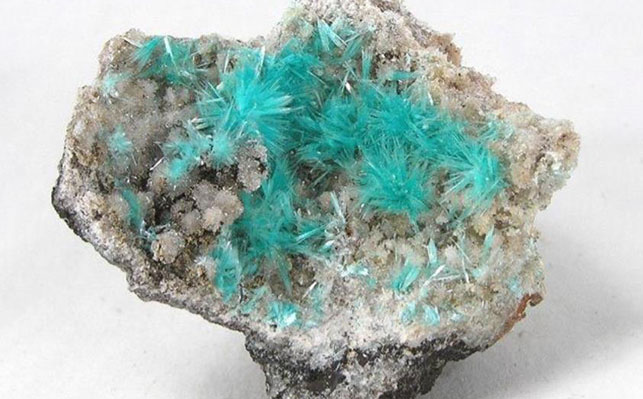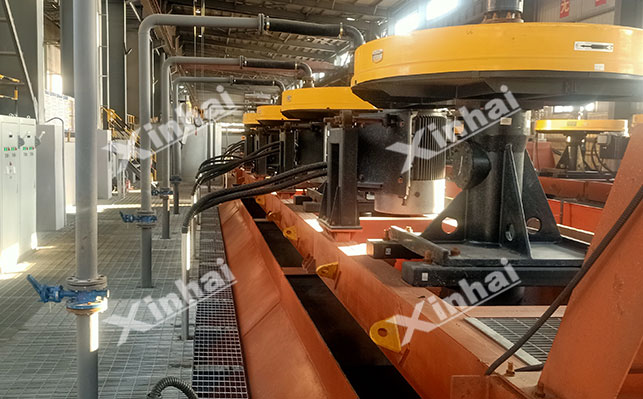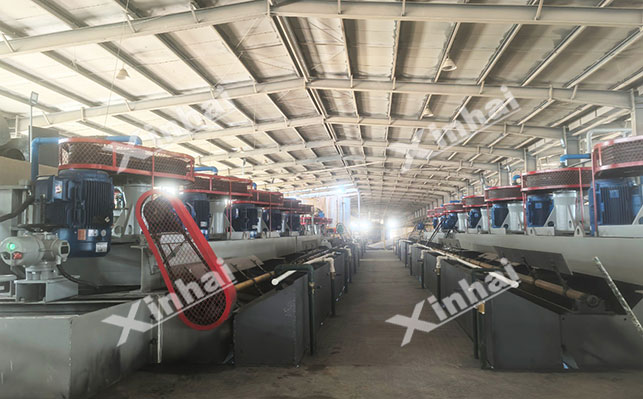
15311826613
Click to add WeChatCopper-zinc ore is a common polymetallic sulfide mineral found in nature. Due to the complex symbiotic relationship and similar surface properties of copper and zinc minerals, it is a typical difficult-to-process ore in the beneficiation field. Differentiated processes are required to effectively separate different types of copper-zinc ores. This article will introduce why copper-zinc ore is so difficult to separate and introduce four copper-zinc beneficiation technologies that can be adapted to the characteristics of various copper-zinc ores to solve the separation problem.
The difficulty in separating copper-zinc ore can be attributed to three main challenges: difficulty in liberation, difficulty in separation, and difficulty in stabilization.

Difficulty in Liberation: In copper-zinc minerals, more than 70% of the mineral particles are distributed in the range of 0.01-0.074 mm, of which 10%-20% are even finer than 0.01 mm. This particle size makes it very difficult to achieve single-particle separation. Furthermore, the morphology of intergrowths of copper-zinc minerals is complex, exhibiting encapsulated, interpenetrating, and gradational intergrowths, further complicating the separation process.
Separation difficulties: This is mainly due to the similar physicochemical properties of the surfaces of copper and zinc minerals, and the further reduction of differences caused by oxidation. This results in weak selective adsorption capacity of collectors for both minerals, and inhibitors are somewhat ineffective.
Stabilization difficulties: During the beneficiation process, the uneven spatial distribution of ore properties and the dynamic fluctuations in the slurry's chemical environment lead to frequent adjustments of process parameters that are difficult to match with actual operating conditions, making it difficult to maintain stable separation indicators.
These three difficulties in copper-zinc ore beneficiation are interconnected and mutually causal. Fine-grained dissemination and intergrowths lead to dissemination difficulties, which in turn allow undissected intergrowths to enter the separation stage, exacerbating the separation difficulty. Similar floatability and oxidation interference further complicate separation, forcing frequent adjustments of process parameters, which in turn leads to stabilization difficulties. The uneven ore distribution and slurry fluctuations further amplify the stabilization difficulties caused by dissemination and separation.
Effective separation of copper-zinc ore requires comprehensive consideration of ore properties and targeted process design. Currently, there are four main methods commonly used in copper-zinc beneficiation: preferential flotation, mixed flotation, flotation column separation, and bioleaching.
This method utilizes the subtle differences in floatability between copper and zinc minerals. By selectively suppressing one mineral with depressants, the other mineral is preferentially floated, achieving a stepwise recovery process of "copper first, then zinc" or "zinc first, then copper." Typically, copper minerals are floated preferentially, followed by activation of zinc minerals for flotation. The crushed and ground slurry is first fed into a primary flotation circuit where depressants are added to suppress zinc minerals, while collectors float copper minerals, yielding copper concentrate. The copper tailings then enter a secondary flotation circuit where activators are added to activate the suppressed zinc minerals, resulting in zinc concentrate.

Inhibitors: Zinc is inhibited in an alkaline pulp using a combination of zinc sulfate, sodium sulfite, and sodium thiosulfate.
Adjusting agents: Limestone is used to adjust the pulp pH to 8-10, enhancing zinc inhibition while preventing over-inhibition of chalcopyrite.
Collectors: Butyl xanthate and ethyl xanthate are used in combination to collect copper minerals, enhancing selectivity.
First, copper and zinc minerals are floated together using a collector to obtain a mixed concentrate. Then, through reagent removal and pulp environment adjustment, secondary separation of copper and zinc is achieved in the mixed concentrate. The standard process is as follows:
Mixed roughing: A combination of amyl xanthate and butylammonium black reagent can be used as a collector under neutral to weakly alkaline conditions to float copper and zinc minerals together, yielding a mixed concentrate;
De-reagent treatment: Residual reagents on the surface of the mixed concentrate are removed through concentration, dehydration, and activated carbon adsorption;
Copper-zinc separation: After de-reagent treatment, the pulp is adjusted to pH 10-11, and a combination of sodium cyanide and lime is added as a depressant to inhibit zinc minerals, allowing copper concentrate to float; the tailings are activating the zinc, allowing zinc concentrate to float.
Mixed flotation is suitable for tightly intercalated copper and zinc minerals (fine particle size).

This method primarily uses flotation columns for countercurrent collisions to enhance the contact between bubbles and minerals. Gravity settling reduces gangue inclusions, achieving high enrichment of copper and zinc minerals.
During operation, microbubble generators at the bottom of the flotation column produce 0.1-0.5mm fine bubbles. The slurry is fed from the middle of the column, colliding countercurrently with the rising bubbles. Water is sprayed at the top to wash the concentrate, and tailings are discharged at the bottom.
The flotation column method is suitable for… This method is particularly suitable for copper-zinc beneficiation and separation in processes requiring high concentrate grades and a high proportion of fine particles.
Bioleaching utilizes the metabolic activity of microorganisms to dissolve copper minerals, achieving copper-zinc separation. Microorganisms oxidize Fe²⁺ in the ore to produce Fe³⁺, converting chalcopyrite to soluble Cu²⁺; sphalerite, due to its high chemical stability, dissolves only in small amounts and remains in the leaching residue. Generally, the ore is crushed to -5mm to ensure permeability, and sulfur powder is added to adjust the pH to 2. The pH level is 0-2.5, which is acidic, providing energy for microorganisms. The temperature is controlled at 30-35℃, and the ore pile humidity is 20%-25%, with continuous oxygen supply maintained through a spray system. Copper is then extracted using an extractant as the leaching solution, followed by electrolysis to produce electrolytic copper, with the tailings recycled.
Bioleaching is generally suitable for processing low-grade oxidized copper-zinc ores.
These are four common methods for copper-zinc ore beneficiation and separation. In actual beneficiation plants, a detailed analysis of ore characteristics is necessary to develop targeted process plans. For easier beneficiation, a focus should be placed on "high-efficiency inhibition." Medium-difficulty ore beneficiation focuses on "liquidation of intergrowths + reagent removal," while ultra-difficulty ore beneficiation requires "multi-process synergy + pretreatment" to overcome separation bottlenecks.
Xinhai has extensive experience in copper, lead-zinc, and copper-lead-zinc polymetallic ore beneficiation. Regardless of the mineral type, Xinhai provides customized solutions tailored to each mine's specific needs. In terms of beneficiation testing, Xinhai can conduct exploratory tests, closed-circuit tests, and pilot-scale tests. From the laboratory to the production line, Xinhai provides comprehensive support, helping mines overcome copper-zinc separation bottlenecks and realize resource value.